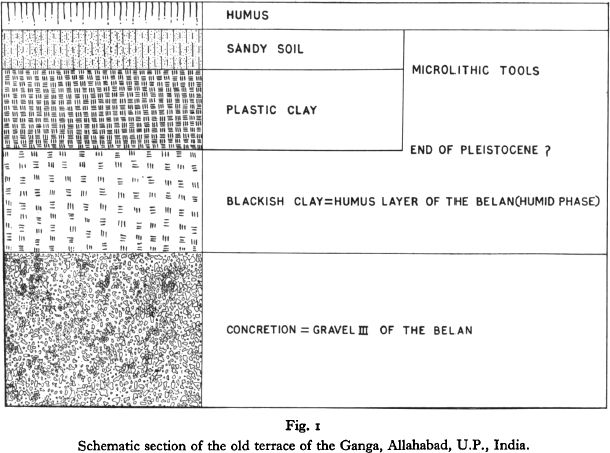Article contents
Mesolithic Lake Cultures in the Ganga Valley, India
Published online by Cambridge University Press: 27 May 2014
Extract
The explorations conducted by the Institute of Archaeology, Allahabad University, in the last few years in the alluvial plain of the Central Ganga Valley, bounded by the Ganga on the south and the Sarju on the north, have brought to light extensive traces of Stone Age occupation in an area completely devoid of rocks. The work has also revealed the connection between this appearance of early man and the morphological features brought about by the changing course of the Ganga in the Pleistocene. The Gangetic alluvial is clearly divided into two distinct formations, the older known as Bhagar, and the younger as Khadar. The terminal of the Bhagar constituted the bank of the Ganga when it was actually forming this area and gradually receding southwards to form the deposit of the Khadar. Over a very wide area the exposed sections of the Bhagar (fig. 1) consist of four layers having a thickness of 8 to 10·5 m. On the top there is a sandy soil (30 cm to 1·50 m) overlying a plastic clay deposit (90 cm to 2 m in thickness). The third layer is constituted by blackish soil (1·50 m to 3 m) full of small kankar nodules. The bottommost exposed layer or the fourth (2 m to 4 m) from the top, containing kankars, is yellowish in colour. There is no doubt that the sandy deposit capping the old formation marks the end of an epoch in the life of the Ganga, and it was deposited by the river with a flood-plane higher by at least 10 metres than its highest flood-plane subsequently recorded.

- Type
- Research Article
- Information
- Copyright
- Copyright © The Prehistoric Society 1973
References
page 129 note 1 The explorations were conducted under the direction of Professor G. R. Sharma with the assistance of Shri V. D. Mishra, Dr R. K. Varma, Shri B. B. Misra and Shri D. Mandal of the Institute of Archaeology, Allahabad University, Allahabad, India. Indian Archaeology—A Review (1969–1970), 36–7Google Scholar.
page 132 note 1 Indian Archaeology—A Review (1962–1963), 37–8Google Scholar.
page 132 note 2 Indian Archaeology—A Review (1963–1964), 51–3Google Scholar.
page 132 note 3 Indian Archaeology—A Review (1966–67), in press.
page 132 note 4 Indian Archaeology—A Review (1963–64), op. cit.
page 133 note 1 Indian Archaeology—A Review (1966–67), op. cit.
page 134 note 1 The excavations of the site, jointly sponsored by the Institute of Archaeology, Allahabad University and the State Department of Scientific Research and Cultural Affairs, U.P., were conducted under the direction of Prof. G. R. Sharma with the assistance of Shri V. D. Misra, Dr R. K. Varma, and Shri D. Mandal of the Department of Ancient History, Culture and Archaeology, Allahabad University. Shri R. C. Singh of the State Department of Archaeology of Uttar Pradesh also participated as a trainee. See also Indian Archaeology—A Review (1969–1970), 43–4Google Scholar.
page 135 note 1 I am thankful to the Anthropological Survey of India and Shri A. Pal of this Department for the help rendered in the cleaning and lifting of the human skeletal material.
page 142 note 1 The discussion of the animal skeletal material is based on a Report on the animal remains from Sarai-Nahar-Rai (Pratapgarh), being prepared by Dr Alur of Dharwar and Dr S. L. Misra, Lecturer in the Department of Zoology, Allahabad University.
page 145 note 1 Indian Archaeology—A Review, 1963–1964, 39Google Scholar.
page 145 note 2 Krishnaswami, V. D. and Soundararajan, K. V., ‘The Lithic Tool-industries of the Singrauli Basin, District Mizapur’, Ancient India, 7, 1952Google Scholar.
page 145 note 3 Soundararajan, K. V., ‘Stone Age Industries near Giddalur, District Kurnnol’, Ancient India, 8, 1952Google Scholar.
page 145 note 4 Todd, K. R. U., ‘Palaeolithic Industries of Bombay’, Jour. Roy. Anthro. Inst. Great Britain and Ireland, 69, 1939Google Scholar.
page 145 note 5 Ghosh, A. K., ‘Laterite and Associated Artifact-Bearing Strata in Eastern India’, Quaternary Soils, ed. Morrison, R. D. and Wright, E. H., 1967Google Scholar.
page 145 note 6 Zeuner, F. E. and Allchin, B., ‘The Microlithic Sites of Tinnevelly District, Madras State’, Ancient India, 12, 1956Google Scholar.
page 145 note 7 Misra, V. N., ‘Two Microlithic Sites in Rajasthan—A preliminary investigation’, The Eastern Anthropologist, 24, Nr 3, 1971Google Scholar.
page 145 note 8 Indian Archaeology—A Review, 1963–1964, 51–3Google Scholar.
page 145 note 9 F. E. Zeuner and B. Allchin, op. cit., 12–13.
page 145 note 10 Tata Institute of Fundamental Research Date List, March 1971.
page 146 note 1 Ibid., May 1970; Misra, V. N., ‘Cultural Significance of Three Copper Arrow-heads from Rajasthan, India’, Jour. of Near Eastern Studies, 29, Nr 4, 1970Google Scholar.
page 146 note 2 Agrawal, D. P. and Kusumgar, S., ‘Radiocarbon Dates of Some Pre-Historic and Pleistocene Samples’, Current Science, 36, Nr 21, 1967Google Scholar.
- 20
- Cited by


